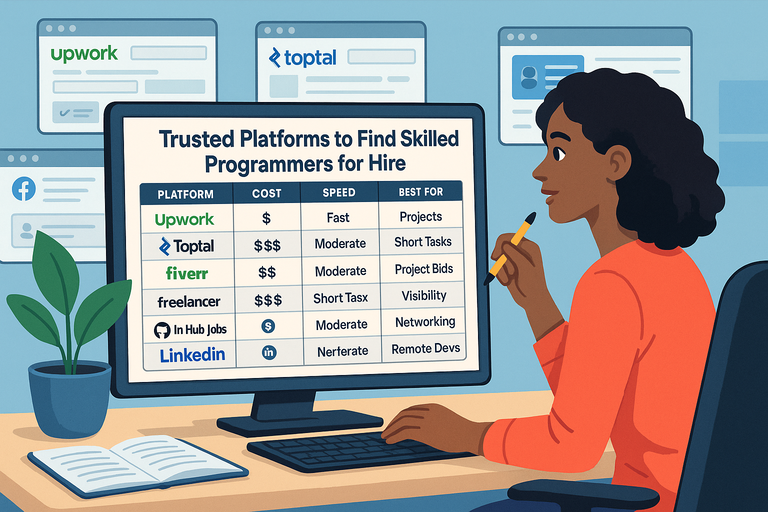Table of Contents
Finding skilled programmers for hire can feel like searching for a needle in a digital haystack. With so many platforms promising access to top talent, how do you know which ones are truly reliable?
In this guide, I’ll walk you through seven trusted platforms where you can confidently connect with experienced developers. Which platform is best for your project’s needs and budget? That’s exactly what we’ll uncover.
1. Hire Expert Programmers On Upwork
Upwork is one of the most recognizable platforms when it comes to finding programmers for hire. With its global reach and user-friendly setup, it’s often the first stop for businesses who need reliable talent at different price points.
How Upwork Connects You With Global Tech Talent
What I like about Upwork is that it feels like a marketplace buzzing with activity. You post a project, set your expectations, and within hours, you’ll usually have programmers from around the world pitching their skills. If you’ve ever wished for a “talent pool on demand,” this comes pretty close.
When you log into the Upwork dashboard, you can either:
- Post a detailed job description, where developers bid on your project.
- Use “Talent Marketplace” to search and invite developers directly.
- Try “Project Catalog” if you prefer pre-defined services (like building a website or fixing code).
The global aspect is powerful. You can choose to hire locally if time zones matter to you, or cast a wider net and find someone overseas, often at a lower hourly rate.
I believe the biggest win here is flexibility—whether you need a 2-hour bug fix or a year-long development partner, Upwork adapts to your needs.
Screening Features That Help You Choose the Right Developer
One of the biggest concerns when hiring programmers online is trust. How do you know the person really has the skills they claim? Upwork tackles this with a few handy features:
- Job Success Score (JSS): A visible rating that shows how often a freelancer has successfully completed projects.
- Work History & Reviews: Clients leave feedback, and you can see exactly what type of projects they’ve handled.
- Skill Certifications: Upwork occasionally verifies specific skills, like coding languages or frameworks.
Here’s what I do: When scanning profiles, I look for not just the technical skills but also communication reviews. A programmer might be a coding genius, but if they’re unresponsive or miss deadlines, that’s a red flag.
Pro tip: Instead of hiring immediately, start with a small paid test task. It’s a practical way to gauge their communication, speed, and coding accuracy before committing to something bigger.
Pricing Models and Payment Protection on Upwork
Money always feels a bit tricky when hiring online, but Upwork has thought through this well. You’ll find two main payment models:
- Hourly contracts: Work is tracked through Upwork’s desktop app, where screenshots and activity levels keep things transparent.
- Fixed-price contracts: You set milestones, fund them in escrow, and release payments only when you’re satisfied.
What I like here is the escrow system—it acts as a safety net. You deposit funds, but the freelancer only gets paid once you approve the work. If there’s ever a dispute, Upwork has a resolution process to mediate.
In terms of cost, programmers on Upwork range widely. I’ve seen junior developers at $15–$25 per hour, while highly specialized experts go well above $100 per hour. The platform fee (roughly 10%) is baked into freelancer rates, so you’ll notice some projects come at a premium.
If budget is tight, posting a fixed-price job with clearly defined deliverables often works best. But for ongoing work like debugging or iterative development, I suggest hourly contracts because they give you more flexibility.
2. Find Programmers for Hire Through Toptal
Toptal positions itself as the “elite” hiring platform. Unlike Upwork, where anyone can join, Toptal is exclusive, only allowing the top 3% of applicants (according to their own standards).
If you’re looking for pre-vetted, highly reliable developers, this is where the search gets serious.
Why Toptal’s Strict Screening Process Matters
I’ll be honest: at first, I thought the whole “top 3%” pitch was just marketing fluff. But after seeing how rigorous their application process is, I realized it’s what makes Toptal stand apart.
Developers go through a five-step screening that includes:
- Language & Personality Review: Ensures clear communication and professionalism.
- Timed Algorithmic Tests: Screens raw coding ability.
- Technical Interview: Hands-on problem-solving with real-world coding scenarios.
- Live Screening Projects: Developers complete test projects judged by senior engineers.
- Continued Excellence: Only those who keep up quality stay in the pool.
This matters for you as a client because you’re not wasting time sifting through hundreds of unqualified applicants. When you request a programmer, you’re almost guaranteed someone who knows their stuff.
If you’ve been burned before by freelancers who looked good on paper but failed in practice, this screening is a lifesaver.
Benefits of Hiring Developers From a Pre-Vetted Pool
The beauty of Toptal is speed and trust. When you tell them your project requirements, they’ll often match you with a candidate in under 48 hours. Instead of scrolling profiles for days, you get a short list of highly vetted options.
Other perks I’ve noticed include:
- Specialized talent: Need a React developer with blockchain experience? They’ll find one.
- Trial period: You get a no-risk trial (usually 2 weeks). If the developer doesn’t work out, you don’t pay.
- Consistency: Developers are used to professional communication and collaboration tools.
I believe the biggest benefit isn’t just the skill level, but the confidence you feel hiring through Toptal. It eliminates second-guessing, which can save weeks of lost time.
For example, a startup I worked with hired a Toptal programmer for a fintech app. Because the developer already had prior fintech experience, onboarding was almost seamless compared to hiring someone from a general marketplace.
Cost Expectations When Hiring From Toptal
Here’s where the reality check comes in: Toptal is not cheap. Programmers usually cost between $60 to $150 per hour, depending on expertise and location. That’s significantly higher than platforms like Upwork.
But the pricing aligns with the quality promise. You’re not just paying for coding skills; you’re paying for peace of mind. When deadlines are tight and failure is not an option, this investment makes sense.
Toptal also works with different engagement models:
- Hourly contracts: Best for flexible, ongoing needs.
- Full-time hires: You can bring in a developer as a dedicated team member.
- Part-time hires: Good for long-term projects where you don’t need someone 40 hours a week.
From my perspective, Toptal makes the most sense for critical projects—think building an MVP for investors, handling sensitive data, or scaling a complex SaaS product. If you just need a quick WordPress fix, this probably isn’t your platform.
3. Use Fiverr to Hire Programmers for Short-Term Projects
If you’re looking for programmers for hire but don’t want to get tied up in a long hiring process, Fiverr is a great option.
It works differently from other platforms because programmers offer pre-packaged “gigs” you can purchase instantly, almost like ordering from a digital menu.
How Fiverr’s Gig System Simplifies Hiring Programmers
Instead of posting a job and waiting for applications, Fiverr flips the script. Programmers create listings (called gigs) where they define exactly what they’ll do, how long it’ll take, and the cost. You browse, pick what you need, and order.
For example, you might see:
- “Fix bugs in your Python script – $25, delivered in 24 hours.”
- “Build a custom WordPress plugin – $150, delivered in 5 days.”
- “Develop a simple iOS app prototype – $400, delivered in 10 days.”
I like this system because it saves time. You don’t need to negotiate upfront — you know the price, the timeline, and the deliverable before you click “Order Now.”
Another bonus: Fiverr organizes gigs into categories and skill sets. So if you’re looking for a Shopify developer, you can filter directly instead of wading through unrelated profiles.
One small tip: If a gig doesn’t quite match your needs, use the “Contact Seller” button. Many programmers are happy to customize their services, even if it’s not in the standard package.
Tips for Evaluating Programmer Portfolios on Fiverr
The trick with Fiverr isn’t finding a programmer — it’s finding the right programmer. Portfolios and reviews are your best friends here.
Here’s how I approach it:
- Check Samples: Most programmers upload screenshots or links to past projects. Pay close attention to whether their style matches your project needs.
- Look at Reviews: Don’t just look at the star rating — read the actual comments. You’ll often learn more from how clients describe communication and reliability than the number itself.
- Response Time: Fiverr shows you how quickly a seller replies. Fast response usually means better communication.
- Revision Policy: See how many revisions are included in the gig. If a project is complex, I recommend picking someone who offers at least 2–3 revisions.
I believe Fiverr works best when you approach it with a test mindset. Order a smaller gig first to see how the programmer handles it, and if you’re satisfied, then scale up to bigger projects.
When Fiverr Works Best for Programming Needs
Fiverr isn’t always the right fit, but it shines in certain situations. Based on my experience, it works best when:
- You need quick, clearly defined tasks (like fixing a bug, adding a feature, or cleaning up code).
- The project isn’t mission-critical but still important (like a one-off WordPress customization).
- You’re experimenting or prototyping and want a fast turnaround without big investment.
For example, I once needed a scraper built for a side project. Instead of hiring long-term, I found a developer on Fiverr who delivered it in 48 hours for under $100. It wasn’t enterprise-level code, but it got the job done.
If you’re running a large-scale SaaS or mission-critical app, Fiverr may feel too transactional. But for short bursts of reliable help, it’s one of the most convenient tools I’ve used.
4. Work With Developers on Freelancer.com
Freelancer.com is another huge marketplace for programmers for hire, and it sits somewhere between Fiverr and Upwork. It gives you the freedom to post projects, invite bids, and then manage the entire collaboration on-platform.
Exploring Freelancer’s Project-Based Hiring Model
Unlike Fiverr, Freelancer.com uses a bidding system. You post your project with a budget range, and programmers bid on it, often including a short proposal about how they’d solve your problem.
Let’s say you post: “Build a custom e-commerce checkout system – $1,000 budget.” Within hours, you might have 20+ bids ranging from $500 to $1,500. This gives you a sense of what’s realistic for your project.
One feature I like is contests. Instead of hiring right away, you can launch a contest where multiple developers submit solutions or prototypes. You only pay the one you like best. It’s a clever way to see real results before committing.
That said, bidding systems can be overwhelming. My suggestion is to be extremely specific in your project description — include deliverables, deadlines, and preferred tech stacks. Clear briefs attract serious bidders, while vague ones attract spam.
Built-In Tools for Managing Remote Programmers
Freelancer.com offers a decent toolkit for keeping remote projects on track. From my dashboard, I usually rely on:
- TimeTracker app: For hourly projects, it logs time and screenshots so you can verify work.
- Milestone payments: Similar to escrow, you fund specific project stages and release them only after approval.
- In-app chat: Useful for keeping communication centralized instead of juggling emails and Slack.
What I’ve found helpful is setting milestones as checkpoints. For example, if I’m hiring a programmer to build an app, I’ll create milestones for wireframes, backend setup, and final testing. That way, I don’t risk paying for incomplete work.
This structure is particularly useful when hiring developers you’ve never worked with before — it builds accountability into the process.
Payment Security and Dispute Resolution on Freelancer
Whenever money changes hands online, I like to know there’s a safety net. Freelancer.com handles this with an escrow system. You fund milestones upfront, but the money isn’t released until you approve the work.
If something goes wrong, you can open a dispute. Both sides present their case, and Freelancer.com acts as the mediator. While it’s not always perfect, I’ve found the process fair when expectations were clearly set in writing from the start.
One point worth noting: Freelancer.com charges service fees both to the client and the freelancer. For clients, it’s usually around 3% of the project cost. It’s not a dealbreaker, but it’s good to budget for.
In terms of costs, you’ll see a wide range — I’ve had bids as low as $10/hour and as high as $100+/hour, depending on the complexity and skill set. My advice: Don’t automatically go for the lowest bid. Instead, weigh value, reviews, and communication.
Freelancer.com makes the most sense for medium-scale projects where you want more control than Fiverr offers but don’t need the exclusivity (and price tag) of Toptal.
5. Discover Skilled Programmers on GitHub Jobs
GitHub Jobs may not be the flashiest platform, but it’s one of the most natural places to connect with serious developers. After all, GitHub is where programmers live, share code, and collaborate. If you want your job post seen by active contributors, this is where you’ll find them.
Why GitHub Is a Go-To Hub for Developer Recruitment
I believe GitHub stands out because it’s not just a job board — it’s a developer’s playground. Millions of programmers use it daily to host code, contribute to open-source projects, and show off their technical chops.
That means when you post on GitHub Jobs, you’re reaching people who are already in the thick of building and problem-solving.
The main advantage is relevance. Unlike general job boards, GitHub Jobs is laser-focused on tech. If you’re hiring for roles like backend engineers, DevOps specialists, or machine learning experts, you’re not sifting through unrelated resumes.
Another benefit: You can actually check a developer’s GitHub profile to see their real-world coding activity. Imagine being able to peek into someone’s coding style, commits, and contributions before even interviewing them. That’s a huge trust booster.
Posting Jobs That Attract the Right Programmer Audience
The key to success on GitHub Jobs is writing job posts that speak directly to developers. Don’t just write a list of demands — frame your post like an invitation to join a meaningful project.
Here’s what I recommend including:
- Stack details: Be specific about languages and frameworks (e.g., “React, Node.js, AWS”).
- Challenges: Developers love solving problems. Highlight what they’ll get to tackle.
- Culture and autonomy: Many developers value flexibility, open-source culture, and remote-friendly work.
If you’re posting, keep formatting clean. Use bullet points, short paragraphs, and avoid corporate fluff. I’ve found that developers on GitHub care more about interesting problems than flashy benefits.
One example: Instead of “We’re seeking a highly motivated developer with strong communication skills,” try “We’re building a real-time data pipeline for IoT devices — you’ll architect it using Kafka and Python.” The second one gets attention.
Insights Into Costs and Job Visibility on GitHub Jobs
GitHub Jobs historically had a flat fee per job listing, making it straightforward compared to platforms that take a percentage of salaries or contracts. While pricing can shift, I’ve always appreciated that it’s transparent and one-time.
The catch? Visibility depends on how appealing your post is. Unlike Fiverr or Upwork, where algorithms push talent to you, GitHub Jobs relies heavily on developers browsing and searching. That means your wording, title, and clarity matter a lot.
In practice, I’ve seen job posts attract strong applicants within days, especially when the role was remote-friendly. Remote tags are like magnets — they instantly widen your reach.
If I were to sum it up: GitHub Jobs works best when you want technically engaged programmers who value real projects over shiny HR branding.
6. Tap Into LinkedIn to Hire Professional Programmers
LinkedIn isn’t just for networking anymore — it’s a goldmine for finding professional programmers for hire.
Whether you’re casually scouting talent or actively recruiting, the platform’s search and recruiter tools make it surprisingly effective.
How LinkedIn’s Networking Features Help Find Developers
I like to think of LinkedIn as the professional handshake of the internet. When you connect with developers here, you’re not just seeing their skills — you’re seeing their career trajectory, endorsements, and professional network.
You can:
- Search directly for developers with skills like “Python” or “Full-Stack.”
- Filter results by location, industry, or company experience.
- See mutual connections for warm introductions.
One personal tip: don’t underestimate the power of messaging. A personalized note goes much further than a generic job invite. Something like, “I noticed you’ve worked on scalable e-commerce systems.
We’re tackling similar challenges and thought you might be interested,” feels more human and gets better responses.
Using LinkedIn Recruiter to Target Skilled Programmers
If you’re serious about hiring, LinkedIn Recruiter is worth exploring. It’s a premium tool that lets you filter candidates more precisely and send “InMail” messages even if you’re not connected.
From the Recruiter dashboard, you can:
- Use advanced filters (years of experience, seniority, coding skills).
- Save candidate lists for ongoing projects.
- Track outreach and responses in one place.
I suggest setting up saved searches. For example, if you’re regularly hiring React developers in North America, you can create a search filter once and let LinkedIn alert you to new matches weekly.
This is one of those behind-the-scenes tricks that saves time and keeps you ahead of competitors who are also hunting for the same talent pool.
Strategies for Writing Job Posts That Attract Talent
LinkedIn job posts work differently than standard postings because candidates often see them in their feeds. To stand out, clarity and authenticity matter.
- Start with the mission: “We’re building tools to make healthcare data more accessible.”
- Add clear role expectations: “You’ll work with Node.js, GraphQL, and AWS to design APIs.”
- Keep buzzwords minimal — developers roll their eyes at “rockstar” or “ninja.”
One thing I’ve found effective is mentioning growth opportunities. Many programmers want to learn new stacks or step into leadership roles, so calling this out can make your listing more appealing.
When done right, LinkedIn doesn’t just bring applicants — it brings applicants who are already invested in their professional development.
7. Source Programmers for Hire on Arc.dev
Arc.dev is a newer player, but it’s carving out a niche by focusing entirely on remote developers. Think of it as Toptal’s younger sibling, but built with flexibility in mind.
What Makes Arc.dev Different From Other Hiring Platforms
The biggest differentiator with Arc.dev is its focus on remote-first hiring. The platform recognizes that most developers today prefer remote flexibility, so it matches clients and programmers with that expectation already set.
Unlike Fiverr or Freelancer, you’re not browsing endless profiles. Instead, Arc.dev pre-vets developers and then introduces you to the ones who best fit your requirements. It’s less noise, more precision.
I’ve also noticed Arc.dev leans into community. They host resources and career support for developers, which means the programmers you meet are often more engaged and motivated.
Benefits of Hiring Remote Developers From Arc.dev
I believe Arc.dev shines if you’re building a distributed team. Some benefits I’ve seen include:
- Pre-vetted talent: Similar to Toptal, developers go through screening for technical and soft skills.
- Global reach: You can tap into talent pools across Asia, Europe, or the Americas.
- Speed: Matches usually happen within a few days, not weeks.
For example, a small SaaS founder I worked with hired a backend engineer through Arc.dev. Because the programmer already had experience with remote workflows (GitHub repos, Slack standups, async updates), onboarding was painless compared to traditional hires.
If you’re new to managing remote teams, this built-in readiness is invaluable.
Pricing and Engagement Models Available on Arc.dev
Arc.dev’s pricing is somewhere between Upwork and Toptal. You’ll find developers in the $40–$100/hour range, depending on experience. They also support flexible engagements:
- Hourly contracts for short-term work.
- Part-time setups for long-term but lighter involvement.
- Full-time placements if you’re essentially looking to hire without going through traditional HR.
I’d recommend Arc.dev if you want vetted talent but don’t want to commit to Toptal-level pricing. It hits that sweet spot of quality without feeling unreachable for smaller teams or startups.
Pro Tip to Close the Article
No single platform is “best” for all situations. The secret is matching the platform to your project’s needs:
- Fiverr for small, quick tasks.
- Upwork or Freelancer for flexible mid-range projects.
- Toptal and Arc.dev for high-stakes, specialized work.
- GitHub Jobs and LinkedIn for long-term hires and career-driven developers.
My best advice? Start with the smallest possible engagement before committing big. Whether it’s a test task on Upwork, a short gig on Fiverr, or a trial period on Toptal, that first project will tell you more than any profile or resume ever could.






